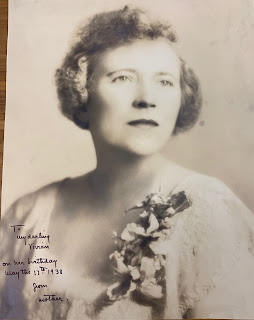Today marks 46 years since Gena Branscombe left this world
leaving behind two daughters, two grandsons, nieces and nephews, friends,
colleagues, beloved members of her Branscombe Choral and a collection of music
that resides at the New York Public Library for the Performing Arts.
Luckily before Gena died Laurine Elkins Marlow met her,
interviewed her over 18 months and wrote her dissertation about her life and
music. Even with the gift of the
dissertation, Miss Branscombe slipped into a “woman composer forgotten”
category. In the ensuing 46 years there
were occasional performances of her songs and choral works then came a burst of
interest in the past 25 years.
In 1998 Kathleen happened upon the name of Gena Branscombe
and her 150 art songs. The rest is
history as told in my many blog postings.
What a 25 year journey it has been #BringingBackBranscombe to the 20th
and now 21st century. The
homage we pay to her life and her music is deserved for a woman who was a
composer, conductor, leader of women, and arts administrator. Her exemplary life and music must be
recognized today.
Here is a timeline for #BringingBackBranscombe
1980 – Dr. Laurine Elkins Marlow’s dissertation – “Gena Branscombe:
American Composer and Conductor: A Study of Her Life and Works
1998 – Kathleen discovers Gena Branscombe’s music at the New
York Public Library for the Performing Arts.
She meets Gena’s eldest daughter, Gena Tenney Phenix and Dr. Laurine
Elkins Marlow.
2000 – Kathleen performs several of Miss Branscombe’s songs
on recitals in New York City, Minnesota and Florida
2003 – Kathleen’s CD, “Ah! Love, I Shall Thee: Songs of Gena
Branscombe” is released on the Albany Records label.
2004 – Premiere in New York City of “Life! Love! Song! A
Visit with Gena Branscombe” – one woman show.
Additional performances at the Festival of Women in the Arts - Elmira, NY, Women in the Arts Conference - St.
Louis, MO, Washington, DC, Long Island, NY, Hofstra University, Stoughton Music
Society – Quincy, MA, Texas A&M University – College Station, TX, Middle
Georgia State University – Macon, GA, Festival of Women Composers – Hartford,
CT and more.
2005- 2020 – Articles about Gena Branscombe published in
various music journals.
CDs released with music of Gena Branscombe:
1996 – “Le Souvenir” – Art Songs
1999 – “By a Canadian Lady” – Piano Music 1841-1997
2005 – “Wishing You and I Were Young Maggie” – Art Songs
2008 - “Remembered
Voices” – Violin Sonata in A Minor
2017 – “Nasty Women” – Piano pieces
2018 - “American Romantics III” – Orchestral work
Lecture Recitals given in Asbury Park, NJ, Library of
Congress - Washington, DC, Indiana University, Indiana, PA, Guildford, VT, St.
Louis, MO, University of Maryland, College Park, MD, and more.
2018 - Copying Gena Branscombe’s “Pilgrims of Destiny”
original conductor’s at the Library of Congress. Entering the score note by note into FINALE
to create a usable conductor’s score for performance..
2019- Dan Ryan conducts the first performance of “Pilgrims
of Destiny” in the 21st century at Clark University in Worcester,
MA. First performance of the work in 79
years.
2019 – Dan Ryan and Kathleen inaugurate The Gena Branscombe
Project and a Board is formed with Dan, Kathleen, Sydney Pepper and Regan
Russell. Website and Facebook pages created.
YouTube channel started. Fund
raising begins to make possible the awarding of scholarships.
2020 – 2023 – The Gena Branscombe Project awards
scholarships to up and coming student composers, conductors and arts
administrators. An art song commission
is awarded.
2022 – Gena Branscombe Scholarship winner Damali Willingham
arranges Gena’s orchestral work, “Festival Prelude” for wind ensemble and
conducts the work at the Berklee College of Music.
2022 – The Gena Branscombe Project sponsors its first
concert – “Bringing Back Branscombe” at Colleges of the Fenway in Boston. Art song premiered composed by our art song
commission winner.
2022 – Dr. Regan Russell defends her doctoral dissertation,
“Love in a Life: The Art Songs of Gena Branscombe” at Boston University.
2022-2023 – Speeches presented – “Bringing Back Branscombe
to the National League of American Pen Women.”
2023 – The Ladies Speak podcast features composer Gena
Branscombe with Kathleen Shimeta as narrator.
2023 – The Gena Branscombe Project sponsors the concert,
“Bringing Back Branscombe to the Upper West Side” in New York City at the New
York Society for Ethical Culture. Gena’s French Horn pieces, Violin Sonata,
songs, piano works and choral works are performed.
2023 – Scholarship winners are performing at the 92nd
Street Y in New York City, Curtis Institute of Music in Philadelphia,
Glimmerglass Opera, 54 Below in New York City, conducting the Boston Landmarks Orchestra, and more.
2023 – Gena accepted into the Canadian Music Centre.
2023 – Gena’s Violin Sonata in A Minor is performed in
Latvia.
The future holds more good news….TBA!
You may be gone from this earth, Miss Branscombe, but The
Gena Branscombe Project is indeed #BringingBackBranscombe! We know you are smiling down on all that is
happening in your name…..”MARVELOUS!”

















































